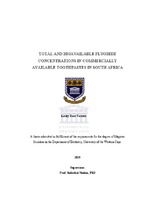| dc.description.abstract | High caries burden coupled with a lack of water and salt fluoridation make it
imperative that toothpastes marketed to the South African consumer demonstrate
adequate caries inhibition. It is generally accepted that an effective toothpaste
contain between 1000ppm and 1500ppm total fluoride (TF) and that of this at least 1000ppm F should be in free available form. Studies conducted in other countries have demonstrated that toothpastes often do not conform to this regulation, indicating the need for quality assessments to be undertaken. Objectives: This study therefore aimed to determine total and free available (potentially bioavailable) fluoride concentrations in 28 adult, fluoridated toothpastes marketed to the South Africa consumer. Labeling practices were also assessed. Materials & Methods: Convenience samples were purchased from a major pharmaceutical and food retailer located in each of the five metropolitan areas of South Africa. Information detailed on the packaging was evaluated for compliance with national standards. Total and bioavailable fluoride concentrations were determined potentiometrically, in quadruplicate, following acid hydrolysis of the samples using a Combination Fluoride Ion Selective Electrode, calibrated with standards containing 0.0625ppm F to 6.25ppm F. Results: Although TF content on analysis was found to be statistically significantly lower than manufacturer declaration (1.2x10-7; p≤0.05), 78.6% still contained adequate free, available F levels. Relative mean available fluoride content for toothpastes formulated with a calcium-based abrasive was 85,5% as opposed to 98.7% for those containing silica. Partial alignment with national labeling statutes was observed for all toothpastes. Conclusion: Most commercially available toothpastes are adequately formulated to provide anticariogenic activity, but consumers should be advised against the use of products containing calcium. Improvements to national standards and stricter regulation of labeling practices are required. | en_US |

